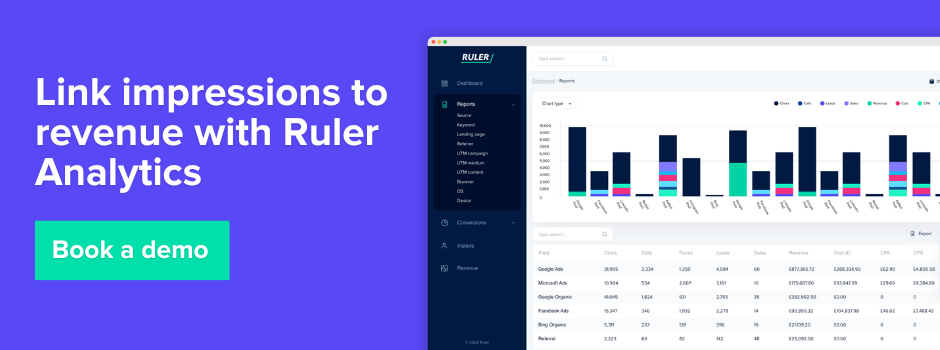TikTok has become a powerhouse for showcasing products and connecting with audiences.
Whether you’re offering a product or a service, TikTok gives you a unique space to reach new leads and even drive revenue.
But there’s the catch, measuring TikTok’s impact isn’t as straightforward as other platforms.
Unlike platforms that offer clear, direct insights, TikTok’s highly visual content and evolving privacy regulations make it a bit tricky to directly track conversions.
This doesn’t mean you can’t understand how well your marketing strategy is doing—it just means you may need a few extra tools to fill in the gaps.
To get the best insights, consider using dedicated analytics tools that dive deeper into performance. These tools can help you get a complete view of your campaign effectiveness, so you’re not just relying on TikTok’s in-app metrics.
Here’s what’s coming up:
💡 Pro Tip
As privacy rules and browser restrictions get stricter and people move through more channels, it’s becoming harder to track and measure campaigns on TikTok and understand their role in the overall customer journey. Ruler’s attribution tool tracks every touchpoint along the way, giving you a clear picture of how your campaigns are doing. Plus, its impression modelling and MMM uses smart stats and machine learning to measure the impact of all your channels, even the high impression ones like TikTok.
Skip to learn more about Ruler’s measurement or book a demo to see it in action.
TikTok’s built-in analytics tools give creators, brands, and advertisers a great way to track performance, understand their audience, and optimise their TikTok strategy.
Here’s a quick breakdown of the two main ways TikTok provides insights: through its native Analytics section and the TikTok Ads Manager.
If you’re working with organic content and want to see how your videos are doing, TikTok’s Analytics section is where you need to go. You can access it by going to Settings > Business Suite > Analytics.
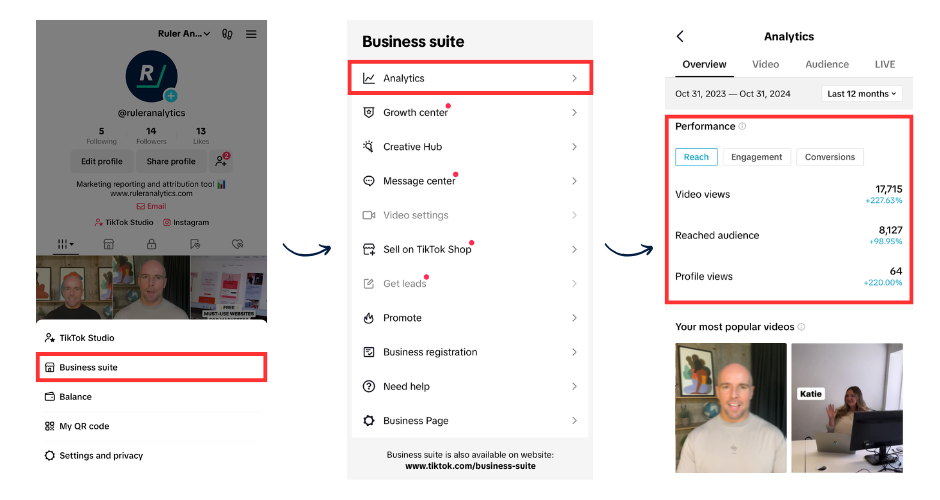
Here, you’ll find:
If you’re running ads, TikTok Ads Manager is where you’ll find a full suite of analytics designed specifically for advertisers.
Along with creating and managing ads, building custom audiences, and setting up campaigns, you get access to Attribution Analytics—a tool that goes beyond the typical last-click measurement model.
Related: How does attribution modelling work on TikTok
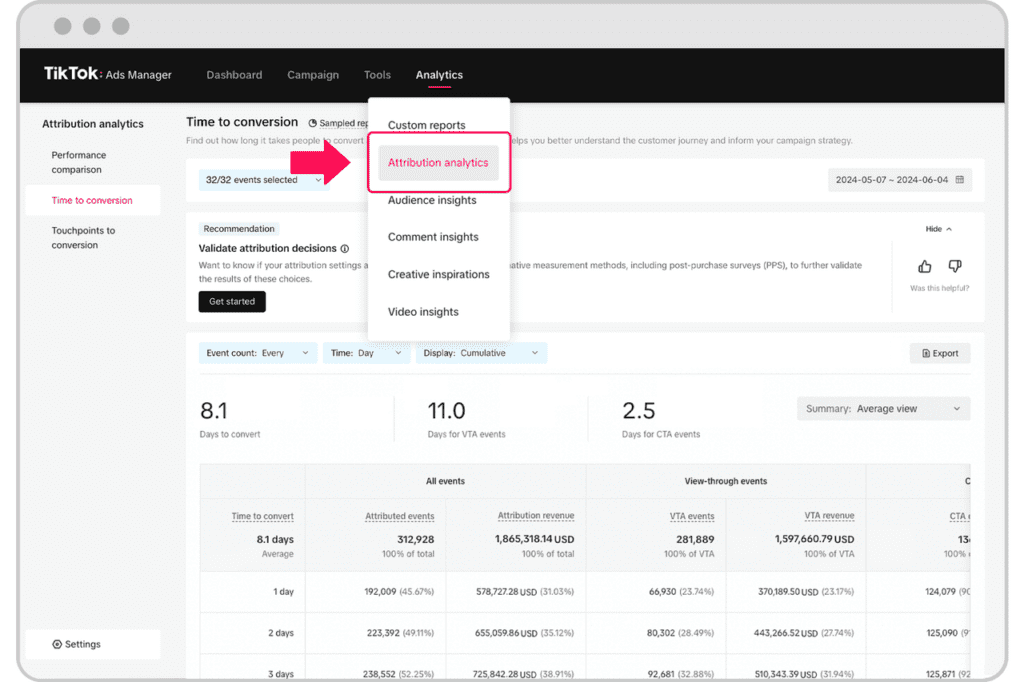
Here’s what you can do with TikTok’s Attribution Analytics:
Performance Comparison – Compare how different attribution windows impact your results. This feature lets you see how changing the attribution window affects key metrics like conversions and engagement.
Time to Conversion – Measure the average time it takes for users to convert after interacting with an ad. It also tracks the number of conversion events that happen daily after ad exposure, giving you a timeline of engagement.
Touchpoints to Conversion – Analyse the ad paths that lead to conversions, so you can see which campaign journeys are the most effective. This insight helps you understand if certain campaigns work well together and how each ad interaction contributes to the final conversion.
While TikTok is making an effort to help advertisers track their results, there are still challenges that exist.
TikTok leans heavily into impression-based campaigns, making it hard for traditional analytics to track its full influence.
Think of the last time you scrolled TikTok and saw a product or brand video you liked, but didn’t click on.
Chances are, you remembered it, searched for it later, and maybe bought it through a different platform.
Standard tools like Google Analytics focus on clicks rather than views, which makes it hard to see TikTok’s real role in nudging users toward a purchase.
TikTok’s built-in attribution tool relies on first-party data—information collected within TikTok itself.
This approach has some gaps because marketers only get a partial view of the customer journey, missing any action users take off the app.
Just like Google might overvalue search ads, TikTok’s tool might lean toward crediting the platform with conversions, even if users interacted with multiple channels before making a purchase.
The result? A biassed view of the true customer journey.
Finally, privacy regulations like GDPR and CCPA add another layer of challenge.
These regulations require users to explicitly consent to data collection, so TikTok and other platforms are often limited to a smaller pool of data for measurement.
In practice, this means the analytics data available is less complete, making it harder to get a full picture of how TikTok impacts the customer journey.
When it comes to measuring TikTok’s impact, TikTok’s own analytics platform is a great start, but it doesn’t always give you a full picture, especially if you’re trying to link it to broader business goals like revenue.
Luckily, there are plenty of other tools that can give you a more rounded view of your TikTok campaigns. Here are some top options that make tracking your metrics beyond TikTok’s app easier:
Ruler kicks things off with its first-party tracking, a method that doesn’t rely on third-party cookies.
Instead, it uses a more sustainable approach, letting you track customers across every touchpoint without limits on attribution windows.
Related: How to view full customer journeys with Ruler
This means you can finally capture the complete customer journey from start to finish, giving you full insight into how potential customers interact with your brand over time.
When someone converts through a form, live chat, or phone call, Ruler links that data back to your CRM and other marketing tools.
By combining your CRM with first-party attribution data, you get a clear look at each touchpoint that leads to your most valuable customers and revenue.
And, all that data feeds back into Ruler’s dashboard, so you can break it down by channel, campaign, ad, or landing page.
Essentially, Ruler lets you see exactly where your leads are coming from and what’s bringing in the best ROI.
As we know, not all interactions are easy to track.
Take TikTok ad views, for example, where it’s tough to pinpoint direct conversions.
To capture these elusive top-of-funnel activities, Ruler uses marketing mix modelling (MMM) and impression attribution.
Related: The future role of impression attribution
Leveraging Bayesian statistics, this model analyses how broader awareness campaigns (like those on TikTok) contribute to your overall marketing impact.
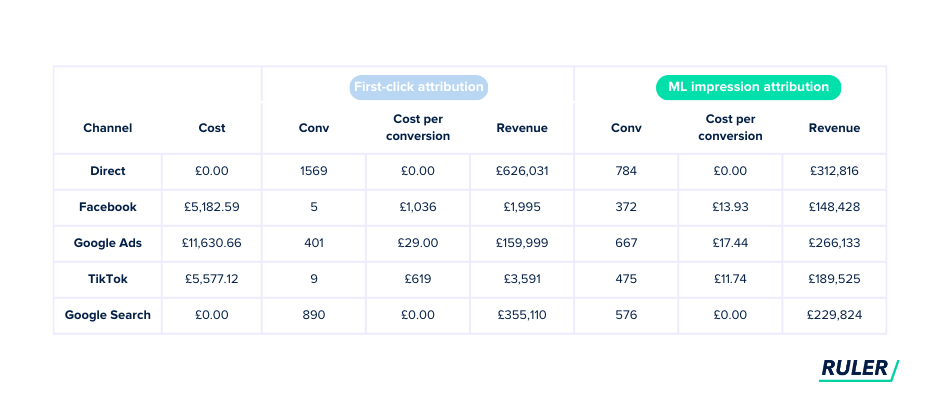
Ruler’s modelling gives marketers predictive insights, showing how adjustments in budget could impact revenue and ROI.
It takes the guesswork out of high-level branding investments, helping you make informed decisions on where to allocate your budget next.
💡 Important note: There’s a lot more you can do with Ruler, especially when it comes to custom reports and segmentation with its filtering features. If you book a demo, we can walk you through everything. Plus, pricing for Ruler’s MMM depends on things like your website traffic and the features you need (products, data, integrations), so it’s best to reach out for a personalised quote.
If you’re looking to optimise your marketing spend but want to avoid deep coding and complex analytics setups, Cassandra might just be the answer.
Cassandra is a MMM tool that leverages machine learning to help businesses understand and improve their marketing efforts—without needing to write a single line of code.
With Cassandra, everything from uploading data to setting parameters and training the model can be handled with just a few clicks.
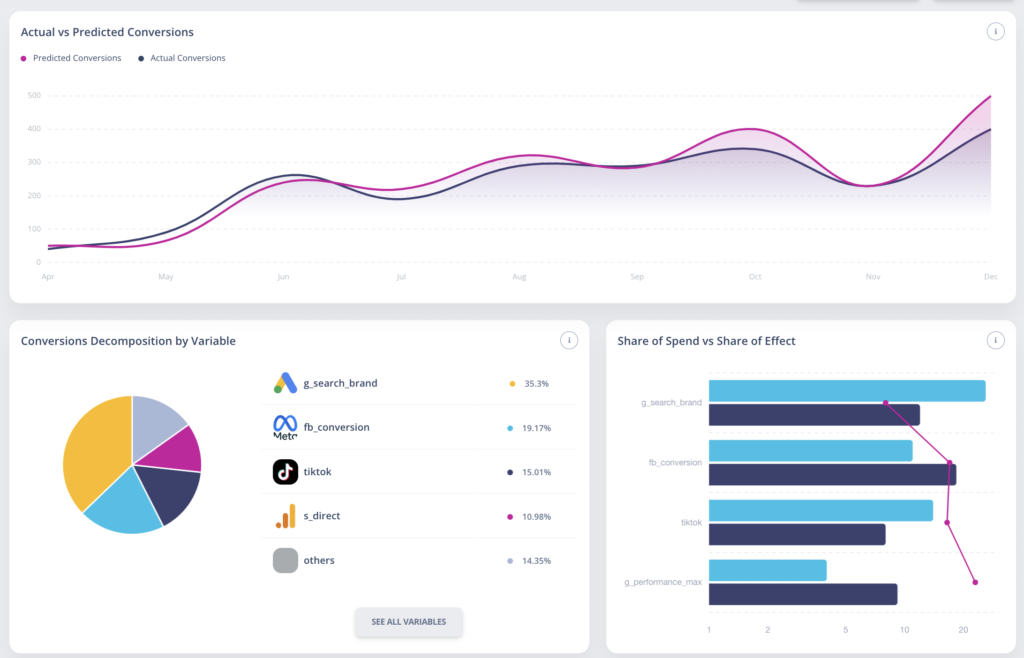
This makes it especially useful for marketers and data analysts who want to gain actionable insights without getting bogged down by technical details. It’s cloud-based, so all the heavy lifting happens online, meaning you don’t have to worry about having specialised hardware or software to get started.
Unlike some MMM tools that focus on deterministic tracking and impression attribution (like Ruler), Cassandra’s analysis uses weekly data granularity. This means it may not capture every short-term effect of a single campaign or promotion, but it provides a foundation for understanding broader trends in your marketing data.
Google Meridian is a powerful tool that utilises Bayesian statistics and TensorFlow to estimate the impact of advertising campaigns.
By quantifying uncertainty, Meridian helps marketers make more informed decisions, even when data is limited.
A key feature is its ability to incorporate reach and frequency data, particularly useful for platforms like TikTok.
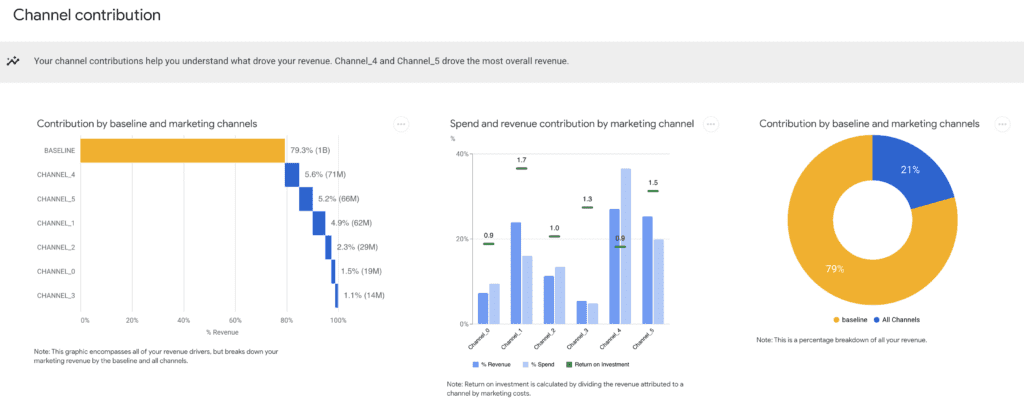
While Meridian offers flexibility and robust statistical modelling, it’s worth noting that some users find it less customisable for specific use cases and might be biassed towards Google’s advertising ecosystem.
Keen is a user-friendly SaaS platform that leverages machine learning to optimise marketing strategies.
It provides real-time insights and historical data to help businesses make data-driven decisions.
While Keen is generally accessible, some users have reported that it requires a bit more hands-on involvement compared to other tools.

It’s a great option for marketers who want to gain a deeper understanding of their TikTok performance and marketing mix but may not have extensive data science expertise.
Meta Robyn, an open-source MMM package from Meta, offers advanced features like budget allocation and diminishing returns modelling.
It’s particularly well-suited for e-commerce brands heavily invested in social media, providing granular insights into Facebook’s performance.
But, its open-source nature means it might have a steeper learning curve and require more technical expertise to implement.
For those willing to invest the time and effort, Robyn can be a powerful tool for optimising marketing strategies.
TikTok’s high impression volumes and changing privacy rules can make it tough to track conversions directly. While they’re working on improving measurement, there are still some hurdles to overcome.
With tools like Ruler, you get more control over your data and better insight into what’s working (and what’s not).
Using first-party click tracking, MMM, and impression attribution, Ruler shows you the full impact of your marketing and gives you clear insights to make smarter, data-driven decisions.
Want to learn more about Ruler? Book a demo today and see how it can help you take your TikTok measurement to the next level.
